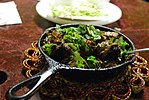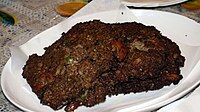|
Pakistani cuisine

Pakistani cuisine (Urdu: پاکستانی پکوان, romanized: pākistānī pakwān) is a blend of regional cooking styles and flavours from across South, Central and West Asia. It is a culmination of Iranic, Indic & Arab culinary traditions. The cuisine of Pakistan also maintains certain Mughal influences within its recipes and cooking techniques, particularly the use of dried fruits and nuts.[1][2] Pakistan's ethnic and cultural diversity, diverse climates, geographical environments, and availability of different produce lead to diverse regional cuisines. Pakistani cuisine, like the culinary traditions of most Muslim-majority nations, adheres to halal principles in accordance with Islamic dietary laws, which prohibit the consumption of pork and alcohol, among other restrictions. Additionally, halal regulations outline specific guidelines for meat consumption, including which animals are considered permissible (halal) and the proper methods of slaughter and preparation to ensure compliance with Islamic dietary practices. Pakistani cuisine is traditionally centered around meat-based dishes. However, the high cost of meat, coupled with widespread poverty,[3] leads many households to substitute meat for more affordable staples such as lentils, rice, and vegetables. International cuisine and fast food are popular in major cities such as Islamabad,[4] Lahore[5], Peshawar[6], Quetta[7], and Karachi[8], where local and foreign recipes often merge to create fusion dishes, such as Pakistani-Chinese cuisine. Additionally, as a result of lifestyle changes, health trends, and new dietary research being published, traditional ingredients such as masala (pre-mixed and ready-to-use) and ghee (clarified butter)—with its health benefits and high smoke point—have been increasingly popular. Similar to other Central Asian cultures, families in Pakistan traditionally dine seated on a dastarkhān—a special rug spread out on the floor. To prevent food spills from soiling the rug, it is typically covered with a plastic sheet or disposable mat. After the meal, tea is customarily served, and family members engage in conversations, relaxing against the large cushions or pillows commonly arranged around the dastarkhān for added comfort. Historical influencesPakistan's national cuisine directly inherits from Indo-Aryan, Turko-Persian, Iranic, and Arab, and it is heavily influenced by Muslim culinary practices. Evidence of controlled preparatory cuisine in the region can be traced back to as early as the Bronze Age with the Indus Valley Civilization. Around 3000 BCE, sesame, eggplant, and humped cattle were domesticated in the Indus Valley;[9] spices like turmeric, cardamom, black pepper and mustard were harvested in the region concurrently.[10] For a thousand years, wheat and rice served as basic comestibles in the Indus Valley region.[11] The arrival of Islam through trade and conquests by various Arab, Turkic, Persian, and Afghan dynasties influenced the local cuisine of the region to a great degree. Due to its Muslim-majority population, Pakistan's cuisine sees a strict observance of Islamic dietary laws. Most prominently, forbiddance on the consumption of pork and alcohol by Islamic regulation has shifted the focus of Pakistani cuisine to other types of meat, such as beef, lamb, chicken, and fish, alongside a variety of fruits, vegetables, and dairy. ElementsPakistani dishes are known for being aromatic. Some dishes contain liberal amounts of oil, contributing to a richer, fuller mouthfeel and flavour. Brown cardamom, green cardamom, cinnamon, cloves, nutmeg, mace, star anise and black pepper are the most commonly used spices in the making of a wide variety of dishes throughout Pakistan. Cumin seeds, chili powder, turmeric, and bay leaves are also very popular. In the Punjab province, spice blends are characterized by their use of coriander powder. Garam masala (a mixture of aromatic spices) is a popular blend of spices used in several Pakistani dishes including Bannu Pulao. Regional cuisinesBalochistanBalochi cuisine originates from Pakistan's Balochistan region, yet many of its dishes have gained nationwide acclaim.[12][13] Among the most popular Balochi dishes are Balochi sajji (skewered lamb or chicken stuffed with rice), mutton rosh (mutton chops) and dampukht (meat slow-cooked in its own fats). Influenced by Iranian culinary traditions, Balochi cuisine is known for its aromatic character while being non-spicy. Khyber PakhtunkhwaThe culinary traditions of Khyber Pakhtunkhwa are deeply rooted in Pashtun culture and are heavily influenced by Turko-Persian culinary traditions. It is characterized by a preference for rice-based dishes, kebabs, and lamb. Prominent dishes include Kabuli palaw, a flavorful rice dish with meat, carrots, and dried fruits; Bannu Pulao, a beef and stock-based rice dish; Chapli kabab, a spiced and crispy minced meat patty; Tika, marinated and grilled meat skewers; and Mutton Karahi, a savory, rich stew. Local variations such as Peshawari cuisine further showcase the diverse culinary practices of the region. Like Balochi cuisine, Pashtun cuisine is traditionally non-spicy. KalashKalashi people have a rich food culture that includes various types of breads and cheese. Some of the widely consumed breads are bilili (walnut bread), jã'u, (walnut bread), and kurau (flour kindled in crushed grape juice). They are made with flour and different types of nuts. Punjab The Punjab province is home to various ethnic groups, resulting in variations in cuisine across the region. Despite these differences, many dishes from Punjab have gained popularity across the region and throughout Pakistan. Northern Punjab, situated in the Potohar Plateau, is known for dishes such as kunna gosht (mutton slow-cooked in a clay pot), hareesa (a smooth blend of wheat, lentils, and meat), and kofta curry (spiced meatballs in a savory gravy), often enjoyed with soft, sesame-topped roghni naan. In Central and Eastern Punjab, signature dishes include murgh/beef pulao, a fragrant rice dish cooked with spices and meat; saag, a mustard leaf-based dish traditionally paired with makai roti (maize flour flatbread); paye/kharoray, a slow-cooked stew made from the legs and joints of cow, goat, buffalo, or sheep; murgh cholay, a flavorful curry of chicken and chickpeas often served with roghni naan; and lassi, a refreshing yogurt-based drink. Additionally, dishes such as nihari (a slow-cooked meat stew), haleem (a rich porridge of wheat, lentils, and meat), and karahi gosht (a spicy curry cooked in a wok-like vessel) are staples. The food in this region is traditionally spicy. SaraikiSaraiki cuisine refers to the native cuisine of the Saraiki people from the Saraiki regions of Pakistan, including Southern Punjab, Northern Sindh, and Eastern Balochistan. Saraiki cuisine is known for its flavorful dishes, often incorporating a variety of spices and ingredients. Key dishes include: Sohbat, Corn on the cob (Makai da Sitta), Murgh Cholay, Kunna Gosht, Saraiki Sajji, Cholistani Pulao, and Moringa flowers' buds curry (locally known as Sohanjrra'n). The most peculiar and popular desserts include Multani Halwa and Phikka Khoya. Sindh Sindhi cuisine refers to the traditional culinary practices of the Sindhi people from the Sindh province of Pakistan. Like most Pakistani culinary traditions, it is predominantly meat-based, with chicken and mutton forming the cornerstone of most meals. Signature dishes of the Sindhi people include Karhi, Daal Pakwan, Palo Fish, and Bhugal Gosht. Sindhi cuisine is typically not spicy, focusing on aromatic and balanced flavors. In contrast, the cuisine of Karachi, the capital of Sindh, reflects the influence of its largely Muhajir (Indian immigrant) population, which constitutes about 90% of the city’s residents. Karachi’s food is known for its bold and spicy flavors, with dishes like Biryani becoming signature staples. Gilgit-BaltistanGilgit Baltistan is rich in unique food and dishes, each district of Gilgit Baltistan has their cultural dish that symbolizes the people. Gilgiti cuisine is the cuisine of Gilgit-Baltistan, Pakistan. It is typically non-spicy, but rich in flavors. Prominent Gilgiti dishes, such as the Chapshoro have gained massive popularity among different parts of Pakistan. Mumtu (dumplings) is another popular dish, often served with yogurt and parsley and black pepper, vinegar, chili sauce. HunzaStaple foods like barley, wheat, and millet form the foundation of dishes such as chapshuro and thukpa, hearty soups that provide warmth in the cold climate. Fresh fruits like apricots and cherries are transformed into jams, dried fruits, and juices, while dairy products like yogurt and cheese play a significant role in both savory and sweet offerings. Dishes like buckwheat bread, rosehip oil bread, and almond bread are commonly prepared in Hunza. NagarChapshuro is the local alternative of pizza in Nagar. Initially a local product of only Nagar valley, now it is widely prepared in Hunza and other localitises on the Karakoram. GhizerGhizer is famous for kelawo (also spelled kilao), walnuts dipped in honey and mulberry juice. GilgitDumplings locally called mumtu are well known in Gilgit cuisine. As Gilgit itself is a blend of cultures from neighboring districts like Hunza, Ghizer and Chilas, the cuisines of these regions is also widely found here. Meal structure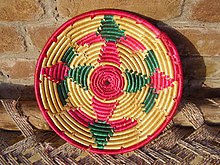 Pakistanis generally have three meals a day: breakfast, lunch, and dinner. During the evening, many families have tea with snacks. Unlike some cultures where snacks are commonly consumed between meals, in Pakistan, snacks are typically reserved for tea time, which usually takes place in the late afternoon or early evening, after children return from school and adults come home from work. During tea time, families sit together and enjoy tea paired with traditional Pakistani cookies and other bakery items. During the holy month of Ramzan (Ramadan), eating patterns change. Muslims observe fasting from dawn until sunset, consuming two meals a day: sehri (or suhur) just before sunrise and iftar at sunset. In line with Islamic tradition and cultural practices observed in many Asian traditions, it is customary to eat only with the right hand. This tradition is followed across all meals, whether casual or formal. Furthermore, it is generally considered impolite or inappropriate to have lengthy discussions during a meal, as the focus is meant to remain on eating respectfully and mindfully. Discussions are typically had post-meal, over tea. Breakfast A typical Pakistani breakfast, locally called nāshtā (ناشتہ), consists of eggs (boiled/scrambled/fried/omelette), a slice of loaf bread or roti, parathas, sheermal, tea or lassi, naan or kulcha with chole or qeema (minced meat), fresh seasonal fruits (mangoes, apples, melons, bananas, etc.), milk, honey, butter, jam, shami kebab or nuts. Sometimes breakfast includes baked goods like bakarkhani, rusks and cookies. During holidays and weekends, halwa poori and chickpeas are sometimes eaten. In Punjab, sarson ka saag (mustard leaves) and maakai ki roti (cornbread) are local favourites. Punjabi people also enjoy khatchauri, a savory pastry filled with cheese. In Pakistan, meat dishes are frequently eaten as breakfast, especially on holidays. A traditional Sunday breakfast might be Siri-Payay (the head and feet of lamb or cow) or Nihari (نہاری) (a dish which is cooked overnight to get the meat extremely tender. The name "Nihari" comes from the Arabic word "Nahar", meaning "Day" or "Daybreak".) Many people used to eat "Bong" (Shank curry) in their Sunday brunch. LunchA typical Pakistani lunch consists of meat curry or shorba (depending on the region) along with a carbohydrate such as rice or bread. Daal chawal is among the most commonly served dishes at lunch. Breads such as roti or naan are usually served for dinner, but have become more common during the day; rice may be served for dinner as well. Popular lunch dishes may include aloo gosht (meat and potato stew) or a vegetable and mutton salan (stew). Chicken dishes like chicken karahi are also popular. Alternatively, roadside food stalls often sell just lentils and tandoori rotis, or masala stews with chapatis. People who live near the main rivers also eat fish for lunch, which is sometimes cooked in the tandoori style. Dinner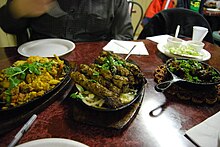 Dinner is considered the main meal of the day as the whole family gathers for the occasion. Food which requires more preparation and which is more savoury (such as biryani, nihari, Bannu pulao, kofte, kebabs, qeema, korma) is prepared. Lentils are also a dinnertime staple. These are served with a bread such as roti or naan or rice, along with yogurt, pickle and salad. The dinner may sometimes be followed by fresh fruit, or on festive occasions, traditional desserts like kheer, gulab jamun, shahi tukray, gajraila, qulfi or ras malai. Snacks and fast foods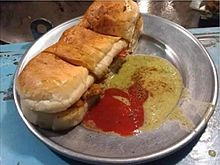 Typical snacks enjoyed during tea time in Pakistan include a variety of bakery items such as cookies, bakerkhani, cakes, pastries, various halva, and nuts, all paired with a warm cup of tea. While tea time holds a special place in Pakistani culture, snacks may also be consumed outside of this context. Often, snacks serve as a quick substitute for a regular meal, such as lunch or dinner, especially when convenience is a priority. These snacks usually comprise food items that are quick to prepare, and usually fried.[15] Some typical snacks are dahi bhala, cutlass (aloo tikki), chaat and samosa chaat, bun kebab, chana masala, chapli kebab, shami kebab, seekh kebab, malai tikka kebab (meat and yogurt), reshami kebab, pakora, and papar. Others include katchauri, samosas (vegetable or beef), bhail puri, daal seu, golgappe, and egg rolls. A given snack may be part of a local culture, and its preparation and popularity can vary from place to place. These snacks are often prepared and sold by hawkers on footpaths, bus stations, around bazaars, and other such places, although they may also be served at restaurants. Main courses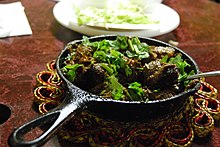 In Pakistan, main courses are usually served with wheat bread (either roti or naan) or rice. Salad is generally taken as a side dish with the main course, rather than as an appetizer beforehand. Assorted fresh fruit or sometimes desserts are consumed at the end of a meal.[citation needed] Meat plays a much more dominant role in Pakistani food, compared to other South Asian cuisines. According to a 2003 report, an average Pakistani consumed three times more meat than an average Indian.[16] Of all the meats, the most popular are goat, lamb and mutton, beef and chicken, which are particularly sought after as the meats of choice for kebab dishes or the classic beef shank dish nihari. Seafood is generally not consumed in large amounts, though it is[17] very popular in the coastal areas of Sindh and the Makran coast of Balochistan and was a dominant element of the cuisine of the former East Pakistan (now Bangladesh). Dishes, with or without meat, combined with local vegetables, such as bitter gourd, cauliflower, eggplant, okra, cabbage, potatoes, rutabaga, saag, and chili peppers are most common and cooked for everyday consumption. A typical example is aloo gosht (literally "potatoes and meat"), a homestyle recipe consisting of a spiced meat and potato stew, prepared in many households. Korma is a classic dish of Mughlai origin made of either chicken or mutton, typically eaten with naan or other bread, and is very popular in Pakistan. Vegetable and legume dishesThere are plenty of vegetarian-friendly vegetable and legume dishes popular in Pakistan. These are often cooked using traditional spices and flavoring agents such as chilis, turmeric, garlic, ginger, cumin, cloves, cinnamon, and fennel seeds. Dishes such as baingan bartha and sarson da saag are typical examples eaten in most homes. Aloo mutter is made with potatoes and peas. There are plenty of vegetables which are grown seasonally in Pakistan, which are cooked into curries which are eaten for lunch or dinner. Some vegetable dishes, such as aloo paratha and channa puri, are also consumed for breakfast. Meat dishesThe meat dishes in Pakistan include bovine, ovine, poultry and seafood dishes. Chicken karahi is a famous poultry dish. The meat is usually cut in 3 cm cubes and cooked in a stew. Minced meat is used for kebabs, qeema, and other dishes. Meat dishes may also be cooked with pulses, legumes and rice. In Sindh poultry, beef and mutton meat are also consumed. The camel, rabbit, many birds like Aari (Fulica atra), Kunj (Demoiselle crane), Titar (Grey francolin), Jhirkri (Sparrow), Duck meat is also consumed. Further important points declare precisely how animals are to be slaughtered; it must be done quickly and with minimal suffering, with the animal's awareness of the situation being extremely brief (preferably nonexistent, as stress releases cortisol and adrenaline, potentially spoiling meat quality). The animals must also be healthy as halal principles forbid the consumption of sick, abused, cancerous or otherwise unhealthy animals. Additionally, animals that are killed inadvertently, or during accidents are forbidden, as the intention was not slaughter in those cases. Barbecue and kebabsMeat and grilled meat have played an important role in Pakistan for centuries. Kebabs are a staple item in Pakistani cuisine today, and one can find countless varieties all over the country. Each region has its own varieties, but some, like seekh kebab, chicken tikka, and shami kebab are especially popular throughout the country and in some other parts of South Asia.
PulsesVarious kinds of pulses or legumes make up an important part of Pakistani cuisine. While lentils (called daal) and chickpeas (called channa/chanay ki daal) are popular ingredients in homestyle cooking, they are traditionally considered to be inexpensive food sources. As such, they are typically not served to guests who are invited for dinner or during special occasions. Meat may be combined with lentils and pulses, whether in simple preparations or in elaborate dishes such as haleem. Beans such as black-eyed peas (lobia) and kidney beans (rajma) are sometimes served in a tomato-based masala sauce, especially in Punjab. Chickpeas, red kidney beans, and other legumes are also popular in Pakistani cooking. They are usually cooked in a spicy gravy and served with rice or traditional flatbread (roti). Chickpeas, known as channa, are also a common breakfast food when served with puri. Channa chaat is another favorite street food and iftaar dish; it is made of chickpeas, chopped onions, tomatoes, and chillies, and seasoned with spices (chaat masala) and tamarind paste. A wide variety of lentils is consumed in Pakistan and frequently with rice. Daal chawaal (lentils and rice) is known as a popular comfort food in many Pakistani households. Rice dishes Pakistan is a major exporter and consumer of rice. Basmati is the most popular type of rice consumed in Pakistan. Dishes made with rice include many varieties of pulao:
Biryani is a very popular dish in Pakistan, and has many varieties, such as Lahori and Sindhi biryani. Tahiri, which is a vegetarian form of biryani, is also popular. All of the main dishes (except those made with rice) are eaten alongside bread. To eat, a small fragment of bread is torn off with the right hand and used to scoop and hold small portions of the main dish. Pickles made out of mangoes, carrots, lemon, etc. are also commonly used to further spice up the food. In the Khyber-Pakhtunkhwa, feasts using mountains of spiced rice combined with pieces of slowly roasted lamb are often served for guests of honour. These kind of pulaos often contain dried fruit, nuts, and whole spices such as cloves, saffron and cardamom.Bannu Pulao, are also popular in the province, particularly in the southern region. Varieties of bread 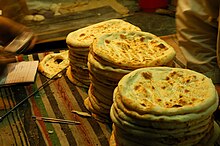 Pakistanis eat breads made of wheat flour as a staple part of their diet. Pakistan has a wide variety of breads, often prepared in a tandoor. The tandoori style of cooking is common throughout rural and urban Pakistan, and also has strong roots in neighboring India, Iran and Afghanistan. Some of these are:
Desserts Popular desserts include Peshawari ice cream, sheer khurma, qulfi, falooda, kheer, Firni, zarda, shahi tukray and rabri. Sweetmeats are consumed on various festive occasions in Pakistan. Some of the most popular are gulab jamun, barfi, ras malai, kalakand, jalebi and panjiri. Pakistani desserts also include a long list of halva, such as Multani Halwa, hubshee, Gajar ka halwa, sohan halvah, Ugham Halwo, Sindhi Halwo, Seero. Kheer made of roasted seviyaan (vermicelli) instead of rice is popular during Eid ul-Fitr. Gajraila is a sweet made from grated carrots, boiled in milk, sugar, cream and green cardamom, topped with nuts and dried fruit. It is popular in Pakistan, as well as in other parts of South Asia, including Afghanistan. Tea varietiesPakistanis drink a great deal of tea, locally called "chai". Both black (with milk) and green teas are popular and there are different varieties common in different parts of Pakistan. [citation needed]
BeveragesBesides tea, there are other drinks that may be included as part of the Pakistani cuisine. All of them are non-alcoholic as the consumption of alcohol is prohibited by Islam. During the 20th century, beverages such as coffee and soft drinks have also become popular in Pakistan. It is very common to have soft drinks nowadays with Pakistani meals.
HalalObservant Muslims follow the Islamic law that lists foods and drinks that are halal, permissible to consume. The criteria specify both what foods are allowed and how the food must be prepared. The foods addressed are mostly types of meat. [citation needed] Foreign influences
In addition to the traditional food, fast food is also very popular across the country.[18] In big cities, there are many international fast food restaurants, such as KFC, McDonald's, Pizza Hut, Subway, Domino's, Burger King, Hardee's, Papa John's Pizza, Dunkin' Donuts, Baskin-Robbins and Taco Bell.[19][20][21][22][23][24][25][26][27] Occasionally, people in Pakistan dine out at restaurants with foreign-influenced food, such as Western, Arab and Chinese dishes. There are many westernized, Chinese restaurants and fast food outlets in urban parts of Pakistan. In the Punjab and Sindh provinces, the majority of urban chains of many American, European and British restaurants have opened in many metropolitan cities, such as Karachi, Lahore, Faisalabad, Islamabad-Rawalpindi, Gujranwala, Peshawar, Multan, Hyderabad, Quetta, Sargodha, Bahawalpur, Sialkot, Sukkur, Larkana and many others. Marketing and advertisements have attracted Pakistanis to try them out. Outside Pakistan, Pakistani cuisine is prevalent in countries where there are large Pakistani communities present. Pakistani food makes use of fresh, hand-pounded masalas. Ghee is used, but the main component of the meal or a dish is meat (beef, lamb, chicken, goat, or fish), and vegetables are sparingly used. Surprisingly, Pakistani food also makes extensive use of olive oil. Sparingly used vegetables does not mean there is no vegetarian food on the menu. Since the cuisine is very similar to Punjabi-style of cooking, tikka, simmered dals, tawa sabzi, and chaat feature here.[28] See alsoReferences
External linksWikimedia Commons has media related to Cuisine of Pakistan. |
